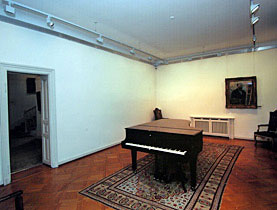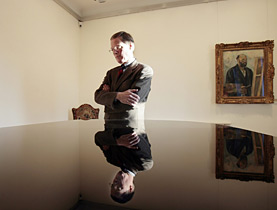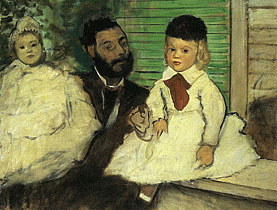Art detective to track stolen paintings

The armed robbers who drove away from the Bührle museum in Zurich with paintings worth SFr180 million ($165 million) have set wheels in motion in the art world.
Cologne-based art detective Ingrid Blom-Böer is one of those working on the case. She spoke to swissinfo about her job tracking down stolen art.
Blom-Böer works for the Art Loss Register, which operates a permanent international database of stolen and missing works of art, antiques and valuables. It is a booming sector estimated to be worth SFr6.6 billion annually
Sunday’s robbery was the largest and most audacious in Switzerland’s history. It was preceded by the theft of two Pablo Picasso paintings from an exhibition near Zurich last week.
swissinfo: What can you do to help find the missing Zurich paintings?
Ingrid Blom-Böer: We have entered the paintings into our database. Thieves always think that after the publicity dies down no one will remember anything about this theft. But the database will never forget anything and we will keep them on our database until they have been found again.
We check catalogues from a lot of auction houses in Europe, the United States and around the world. We search through all these catalogues before the auctions take place. If we find anything that happens to be registered on our database, we inform the auction house.
We contact the victim, we contact the police and we try to get the piece back to the rightful owner. This might take months, or years… every case is different.
swissinfo: What are the options for criminals in possession of four extremely famous and valuable paintings?
I.B-B.: It’s not possible to put them back on the legal market. Everyone knows they have been stolen and any reputable dealer would go to the police if they came across them, although some thieves are stupid enough to try that.
These paintings will probably act as currency in a sort of underworld of organised crime gangs. They may be used in payment or exchange for money laundering purposes or in connection with drugs or weapons trafficking.
The other option is “art-napping” where the robbers follow the same procedure as kidnapping. They make contact with the owners and demand a certain sum of money for the return of the paintings.
swissinfo: The gang that targeted the Bührle Collection selected four of the most valuable paintings. Is that a common feature of this kind of robbery?
I.B-B.: If you follow the large important auctions you know exactly what these paintings are worth and that attracts the interest of criminals. The thieves are not taking the paintings to enjoy them. They have different goals.
In perhaps two per cent of cases there might be a buyer who would like to have these paintings and just keep them. But as far as we know in most cases the stolen items circulate as part of criminal business.
swissinfo: What well-known stolen items has the Art Loss Register helped to recover?
I.B-B.: We had one Paul Cezanne painting – Tin jug and fruit – which was stolen in 1977 and turned up 20 years later. We were involved in that case which was very complicated with many people involved. Some of them didn’t want to talk to us at first.
But we always do our best to work together with all the institutions we usually deal with to resolve the matter.
swissinfo: What other objects are on your register?
I.B-B.: We have objects in different categories such as rugs, silver, paintings, books and even vintage cars, all with a value of at least €1,000. To add a piece to the database we need to have as much information as possible, such as information on the artist, the medium, measurements and a good picture.
swissinfo: How does one become an art detective?
I.B-B.: You need to have a background in art, art history, or archaeology and then it’s a case of course of learning by doing. Having a good eye is important too.
We are in contact with the police but it’s not our job to hunt for stolen items in the criminal world. We do our job in the office and the police do their job investigating.
The Art Loss Register runs the world’s largest database of lost or stolen art work and was set up in 1991 by auction houses, insurers and art dealers.
It manages some 150 recovery cases worldwide at any one time.
The register has offices in London, New York, Amsterdam and Cologne.
The FBI estimates the stolen art market at SFr6.6 billion annually, and Interpol has about 30,000 stolen works listed in its database. Only a fraction of stolen art works are ever found but thefts are rare because of intense police investigations and the difficulty in selling the works.
The four paintings stolen from the Bührle collection were:
Claude Monet’s “Poppy field at Vetheuil”
Edgar Degas’ “Ludovic Lepic and his Daughters”
Vincent van Gogh’s “Blooming Chestnut Branches”
Paul Cezanne’s “Boy in the Red Waistcoat”.
The two Picasso oil paintings stolen from the Pfäffikon Cultural Centre in canton Schwyz were:
“Tete de cheval” (Horse’s head)
Verre et pichet (Glass and pitcher)
They were on loan from the Sprengel Museum in Hannover, Germany.

In compliance with the JTI standards
More: SWI swissinfo.ch certified by the Journalism Trust Initiative



You can find an overview of ongoing debates with our journalists here. Please join us!
If you want to start a conversation about a topic raised in this article or want to report factual errors, email us at english@swissinfo.ch.